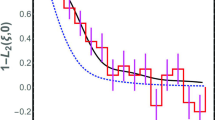Abstract
We have analysed experimental data on the tensile strength of carbon fibres and bundles of parallel carbon fibres. These data are used to assess whether theoretical relations between the strengths of fibres and different kinds of bundles are consistent with experiment. The analysis confirms the presence of a hybrid effect, and also that the classical Weibull relations between strength and length are not apparently satisfied for bundles. It is suggested that the latter observation might be an effect of the random variation of fibre diameter, and some consequences of this are examined.
Similar content being viewed by others
Abbreviations
- y :
-
tensile stress
- L, L1, L2 :
-
length of fibre or bundle
- F(y; L) :
-
failure probability (single fibre)
- f(y; L) :
-
density of failure stress, i.e. δF/δy
- \(\left. {\begin{array}{*{20}c} {\mu ,y_1 ,\varrho ,} \\ {y_L ,\varrho _L ,y'_L ,} \\ {\varrho '_L } \\ \end{array} } \right\}\) :
-
parameters of F
- l :
-
likelihood function
- Y i :
-
datum (failure stress in ith specimen)
- κ 2 v :
-
chi-square distribution with v degrees of freedom
- χ 2υ,α :
-
percentage point of χ 2υ (i.e. if X has distribution χ 2υ then P{X > χ 2υ,α })
- y *, μ*, σ * N :
-
defined from F(y, L), 0⩽y<∞ (used in dry bundles analysis)
- G N (y; L) :
-
failure probability for a bundle of N fibres
- δ :
-
ineffective length
- m :
-
= L/δ: number of segments in chain-of-bundles model
- K k :
-
stress concentration coefficient when k consecutive failures
- q k :
-
number of neighbours having stress concentration Kk
- k * :
-
critical number of consecutive failures
- y *1 , ϱ* :
-
Weibull parameters for bundles
- α, α * :
-
powers of L in modified model for fibres and bundles, respectively
- β :
-
cross-sectional area of fibre
- F(y; L, β) :
-
failure probability conditional on β
- \(\left. {\begin{array}{*{20}c} {\mu ,y_0 ,\gamma ,} \\ {\eta ,c,c*} \\ \end{array} } \right\}\) :
-
parameters of modified model
- g, g1 :
-
densities of β and β η
- ¯g, ¯g1 :
-
Laplace transforms of g, g1
- E :
-
mathematical expectation
References
H. E. Daniels, Proc. R. Soc. A 183 (1945) 404.
B. W. Rosen, AIAA J. 2 (1964) 1985.
C. Zweben, ibid. 6 (1968) 2325.
D. G. Harlow and S. L. Phoenix, Int. J. Fracture 17 (1981) 347.
Idem, ibid. 17 (1981) 601.
R. L. Smith, Proc. R. Soc. A 372 (1980) 539.
R. L. Smith, S. L. Phoenix, M Greenfield, R. B. Henstenburg and R. Pitt, ibid. 388 (1983) 353.
S. B. Batdorf, J. Reinf. Plast. Compos. 1 (1982) 153.
M. G. Bader and A. M. Priest, in “Progress in Science and Engineering of Composites”, edited by T. Hayashi, K. Kawata and S. Umekawa (Japanese Society for Composite Materials, Tokyo, 1982) p. 1129.
P. W. Manders and M. G. Bader, J. Mater. Sci. 16 (1981) 2233.
Idem, ibid. 16 (1981) 2246.
P. W. Manders, M. G. Bader and T.-W. Chou, Fib. Sci. Tech. 17 (1982) 183.
S. B. Batdorf and R. Ghaffarian, J. Reinf. Plast. Compos. 1 (1982) 165.
W. Weibull, Proc. Ing. Vetenskapsadak 151 (1939).
L. N. McCartney and R. L. Smith, J. Appl. Mech. 105 (1983) 601.
R. A. Fisher and L. H. C. Tippett, Proc. Camb. Phil. Soc. 24 (1928) 180.
M. G. Kendall and A. Stuart, “The Advanced Theory of Statistics”, Vol. 2, 3rd edn. (Griffin, London, 1973).
A. S. Watson, unpublished MSc dissertation, Imperial College (1983).
S. L. Phoenix and H. M. Taylor, Adv. Appl. Prob. 5(1973) 200.
R. L. Smith, Ann. Prob. 10 (1982) 137.
J. M. Hedgepeth and P. Van Dyke, J. Compos. Mater. 1 (1967) 294.
H. Fukuda, J. Mater. Sci. 19 (1984) 974.
D. G. Harlow, Proc. R. Soc. A 389 (1983) 67.
W. Feller, “An Introduction to Probability Theory and Its Applications”, Vol. 2, 2nd edn. (Wiley, New York, 1971).
N. G. De Bruijn, Nieuw. Arch. Wisk. 7 (1959) 20.
N. H. Bingham, C. M. Goldie and J. L. Teugels, “Regular variation” (Cambridge University Press) in press.
S. L. Phoenix, H. D. Wagner and P. Schwartz, Cornell University manuscript MSD-83-01 (1983).
Author information
Authors and Affiliations
Rights and permissions
About this article
Cite this article
Watson, A.S., Smith, R.L. An examination of statistical theories for fibrous materials in the light of experimental data. J Mater Sci 20, 3260–3270 (1985). https://doi.org/10.1007/BF00545193
Received:
Accepted:
Published:
Issue Date:
DOI: https://doi.org/10.1007/BF00545193




